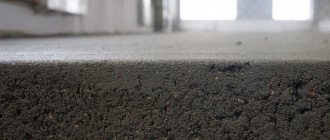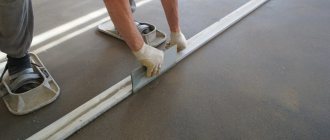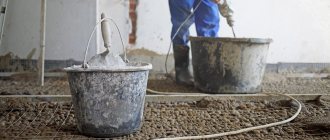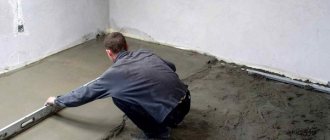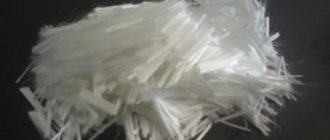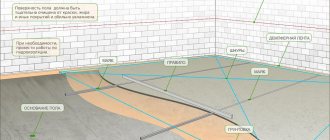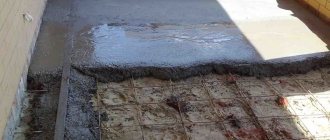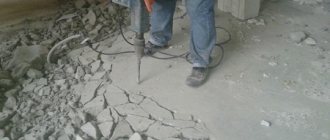The quality of the subfloor depends on two factors. The first is a correctly selected and prepared mixture for floor screed, and the second is the impeccability of its installation in compliance with all technological nuances. Since the selection and purchase of all materials necessary for repairs are often undertaken by the developers themselves, it is important to understand the types of such mixtures and the features of their use. This publication will answer many questions about choosing a screed.
Screed during installation Source odstroy.ru
Purpose of the screed and requirements for it
A screed is a solid foundation created on the floor surface and serves as the basis for installing the finishing floor covering. It can be dry, semi-dry and wet, depending on the materials used and the technology of their installation. We are interested in the traditional wet screed, so called because it is created from a liquid, flowing solution, which becomes hard and durable as it dries. To prepare such a solution, you need a dry mixture for floor screed, which is mixed with water.
The type and thickness of the screed depend on its purpose.
- Leveling the original base.
The need for leveling may arise both to eliminate surface defects (pits, cracks, joints between slabs) and to bring it to a horizontal level. Often you have to solve both problems at the same time. The minimum thickness of the screed is 30 mm.
- Create a planned slope.
A screed with a slope allows you to organize water flow to drain holes, drains and gutters in “wet” rooms - bathrooms, showers, laundry rooms. At the lowest point, the thickness of the screed should be at least 20 mm.
When installing beacons, take into account the minimum permissible thickness of the screed at the drain hole Source dvervdom.ru
- Screed over a layer of heat and sound insulation.
The hardened screed mixture protects the fragile material from mechanical damage and allows the load from the weight of people, furniture, and equipment to be distributed as evenly as possible. Since under the screed in this case there is a movable and fragile layer of materials, it is made at least 40 mm thick.
- Hiding utility lines running along the floor.
The screed not only masks pipes and cables, but also protects them from damage. For the protection to be reliable, it must rise above the communications by at least 45 mm.
- Installation of a heated floor system.
In this case, the screed not only protects the water coil or electrical cable from damage, but also accumulates heat and distributes it evenly over the floor surface. The optimal thickness for it is 50-60 mm.
Water heated floor in a screed Source sk-resultat.ru
The maximum permissible maximum thickness of the screed is provided only for heated floors - it should not exceed 100 mm so that thermal energy is not wasted on heating the concrete. In other cases, they are guided by considerations of the optimal balance between cost and strength of the coating, always taking into account the permissible load on the floors.
Delivery cost for screed mortar
Delivery cost for one concrete mixer truck including VAT:
| Distance | ABS 6 m3 | ABS 7 m3 | ABS 8 m3 | ABS 9 m3 |
| up to 5 km | 1500r (250r/m3) | 1750r (250r/m3) | 2000r (250r/m3) | 2250r (250r/m3) |
| up to 10 km | 2040r (340r/m3) | 2380r (340r/m3) | 2720r (340r/m3) | 3060r (340r/m3) |
| up to 15 km | 2220r (370r/m3) | 2590 RUR (370 RUR/m3) | 2960 RUR (370 RUR/m3) | 3330rub (370rub/m3) |
| up to 20 km | 2490 RUR (415 RUR/m3) | 2905r (415r/m3) | 3320r (415r/m3) | 3735r (415r/m3) |
| up to 25 km | 2880r (480r/m3) | 3360r (480r/m3) | 3840r (480r/m3) | 4320r (480r/m3) |
| up to 30 km | 3270r (545r/m3) | 3815r (545r/m3) | 4360r (545r/m3) | 4905r (545r/m3) |
| up to 35 km | 3600 RUR (600 RUR/m3) | 4200r (600r/m3) | 4800r (600r/m3) | 5400r (600r/m3) |
| up to 40 km | 3960r (660r/m3) | 4620r (660r/m3) | 5280r (660r/m3) | 5940r (660r/m3) |
*In accordance with the legislation of the Russian Federation (from July 13, 2015 N 248-FZ), the loading of mixers with concrete should not exceed 5 m3.
Types of mixtures by type of binder
The binding agent for the screed, which ensures its hardness and solidity, can be cement or gypsum.
Cement
Cement-sand mixture for floor screed is the most popular due to its versatility. It is resistant to moisture and damage from loads and mechanical influences, and can serve as the basis for any covering from parquet to porcelain tiles and self-leveling flooring.
Under the laminate or parquet on the screed, it is enough to lay a thin underlay Source ros-pipe.ru
See also: Catalog of companies that specialize in finishing materials and related work
Another advantage of cement mixtures is their long “survivability”: after mixing the solution, they retain plasticity and do not set longer than gypsum mixtures. Disadvantages include:
- tendency to cracks when drying and shrinking;
- tendency to crack when installed on wooden bases;
- heavy weight;
- high price.
Plaster
Only ready-made floor screed mixtures are gypsum; you won’t be able to mix a solution with the required characteristics yourself. The main disadvantage of gypsum is its low moisture resistance, due to which such screed can only be installed in dry, heated rooms with minimal risk of leaks. Ceramic tiles cannot be laid on it, since the moisture contained in the tile adhesive will be absorbed into the gypsum backing and destroy it.
For reference! Portland cement or polymer additives are usually added to gypsum-based mixtures to increase their strength and moisture resistance.
Rusean Nivelir gypsum mixture with polymer additives Source rerooms.ru
Such screed is rarely used, even though it costs less than cement screed, has better thermal insulation properties and good vapor permeability. All these advantages are instantly lost when moisture gets into it.
Selection of materials
Construction materials stores sell a mixture of TsPS or PDS (depending on the manufacturer's labeling). The packaging indicates the ratio of components and the required amount of water to obtain the design workability. To save renovation budgets, individual developers often purchase consumables and mix them themselves. This semi-finished product is called prancing.
Sand
The standard range of suppliers of non-metallic materials usually does not include sand for sand concrete. The most correct option for this structural material is the following composition:
- sand fraction 0.5 mm - serves as a fine filler;
- sand of fraction 3 – 7 mm is used instead of traditional crushed stone as a coarse filler.
This condition is not met by all manufacturers of dry mixes, and manufacturers of non-metallic materials rarely separate sand into fractions. Therefore, the developer has to be content with an assortment of quarry and river construction sand.
Types of construction sand.
To ensure a high service life of the screed, it is necessary to take into account the following nuances:
- quarry sand has the highest percentage of clay in the form of individual particles or a film on the surface of sand grains;
- in any form, clay is extremely dangerous for concrete structures and products;
- when moisture penetrates it, it swells and increases in volume when it freezes;
- the structure of the structural material is weakened by numerous microcracks;
Therefore, the best options for an individual developer are:
- river sand - clay is washed out by the current, but the particles have a round shape and low adhesion in the structure of the cement stone;
- washed quarry sand - ragged grains of sand firmly adhere to the binder and each other;
- granotsev as a coarse binder - the particle sizes of this material are smaller than crushed stones, and the strength is approximately the same as quartz.
Granotsev instead of crushed stone for concrete screed.
Cement
For screeds, Portland cement grades M400 and higher are used. The presence of additives within 20% by weight is allowed; 2 - 3% of gypsum is included in the cement composition by default to regulate the setting of the structural material.
The material is in high demand; to avoid buying a counterfeit, you should check the packaging for the manufacturer’s details and instructions for use.
Water
Unlike foundations and sub-concrete, natural bodies of water are usually not used at the finishing stage. Therefore, the water quality by default meets the requirements of SP and GOST 23732 standards:
- dissolved salts within 5 g/l;
- suspended matter not more than 0.2 g/l;
- pH within 4 – 12.5 units;
- complete absence of dyes, oils, fats, petroleum products;
- phenol, sugar, surfactants within 10 mg/l.
Recommendations for the water-cement ratio are given below in this article.
Fiber
Instead of laying standard meshes, you can make micro-reinforcement of the screed in the mass. To do this, when mixing concrete, glass fiber or steel, propylene, basalt, and glass fiber are added to it.
Fiber-reinforced concrete with steel fibers.
The best option for leveling screeds and layers of concrete for the manufacture of gravity slopes (baths, shower stalls) is basalt fiber reinforced concrete. Deformations from high operational loads are tolerated by this material in an elastic state without any consequences.
Basalt fiber.
Ready-made and homemade mixtures
The desire to save on repairs or construction is completely normal for most owners of private houses. These activities are very expensive, so many people try to make the cement-sand mixture for the screed, which will be hidden by the finishing decorative coating. If there is no need to save or you need to speed up the pace of construction, it is easier to buy a ready-made mixture.
Classic cement-sand mixture
Homemade solutions have not lost popularity even with the advent of ready-made dry mixtures for one simple reason - they are cheaper. To prepare them you need cement, sand and water - the ingredients are available and inexpensive. For better plasticity and ease of installation, plasticizers are added to them.
Plasticizer for screed Source cloudinary.com
DSP for floor screeding in any room of the house must have a strength of M100 or M150. Where a large load on the floor is expected, for example, in a garage or workshop, the strength is increased to M200. The proportions of M400 cement and sand for these grades are as follows:
- M100 – 1:4;
- M150 – 1:3;
- M200 – 1:2.5.
When mixing, it is important to correctly determine the required volume of water so that the solution turns out to be the desired consistency - not too dense, but not liquid either. Both excess and lack of water reduces the technical characteristics of the DSP. Many years of experience of builders suggests that one volume part of cement should be 0.65-0.7 parts of water, and the moisture content of the sand must be taken into account.
A plasticizer is added to the water to mix the solution; the dosage is indicated on the packaging.
Our concrete pumps for concrete supply
Truck-mounted concrete pump – 16 m
Price per shift (8 hours) of work, including VAT, 18% 14 000 ₽
Price per hour of work, including VAT, 18% 1 800 ₽
Truck concrete pump 18 m
Price per shift (8 hours) of work, including VAT, 18% 16 000 ₽
Price per hour of work, including VAT, 18% 2 000 ₽
Truck concrete pump 28 m
Price per shift (8 hours) of work, including VAT, 18% 18 000 ₽
Price per hour of work, including VAT, 18% 2 250 ₽
Truck concrete pump 32 m
Price per shift (8 hours) of work, including VAT, 18% 19 500 ₽
Price per hour of work, including VAT, 18% 2 440 ₽
Truck concrete pump 36 m
Price per shift (8 hours) of work, including VAT, 18% 22 000 ₽
Price per hour of work, including VAT, 18% 2 750 ₽
Truck concrete pump 42 m
Price per shift (8 hours) of work, including VAT, 18% 30 000 ₽
Price per hour of work, including VAT, 18% 3 750 ₽
Truck-mounted concrete pump 46 m
Price per shift (8 hours) of work, including VAT, 18% 35 000 ₽
Price per hour of work, including VAT, 18% 4 375 ₽
Truck concrete pump 52 m
Price per shift (8 hours) of work, including VAT, 18% 38 000 ₽
Price per hour of work, including VAT, 18% 4 750 ₽
Truck-mounted concrete pump 56 m
Price per shift (8 hours) of work, including VAT, 18% 46 000 ₽
Price per hour of work, including VAT, 18% 5 750 ₽
Truck concrete pump 60 m
Price per shift (8 hours) of work, including VAT, 18% 51 000 ₽
Price per hour of work, including VAT, 18% 6 375 ₽
Truck concrete pump 62 m
Price per shift (8 hours) of work, including VAT, 18% 53 000 ₽
Price per hour of work, including VAT, 18% 6 625 ₽
* The minimum operating time of a concrete pump is 8 hours (7+1) * Rent a concrete pump, the price is within 30 km. from Moscow
Video description
How to make a screed on expanded clay to reduce the load on the base, watch the video:
Ready-made formulations
Ready-made floor screed mortar is not sold in stores, but you can buy a dry mixture and simply dilute it with water according to the instructions, without choosing the proportions. This is very convenient: you don’t need to separately purchase plasticizer, cement and sand, sift it, carry it in buckets to a concrete mixer, and take into account its moisture content when adding water. But you will have to pay more for convenience. How much depends on the composition of the mixture, which may include a variety of improving additives. For example, fiberglass that reinforces the screed, or polystyrene foam granules that lighten it.
Such mixtures have many advantages over homemade ones.
- They are easy to knead with a construction mixer or a drill with an attachment in a container of suitable volume.
- Most of them can be laid in a thinner layer than required by construction requirements, without losing the strength of the created coating.
- They are self-leveling and require less effort to create a level, level surface.
Smooth, smooth and durable screed from the finished mixture Source materik-m.ru
Installation of beacons
An important task when pouring screed is to maintain a perfectly even level of its surface. It can only be observed if special beacons are installed
They must be placed at the same level, controlling the process using a building level.
The installation process is simple:
- as fastening, small slides of gypsum mortar are used, laid along a pre-marked line for installing the lighthouse;
- A wooden or aluminum beam is laid on this line, representing that same lighthouse;
- Using a level, the compliance of the height of each beacon is checked.
Briefly about the main thing
The advent of ready-made mixtures for screed construction has greatly facilitated the work of builders and made their results better. Among them you can find compositions suitable for various purposes - pouring a subfloor, installing a smooth coating under linoleum or parquet, creating a heated floor system, etc. But homemade floor screed solutions made from a mixture of sand and cement also remain relevant. Their strength is quite sufficient for residential buildings and utility rooms, and the cost is significantly lower.
Semi-dry floor screed price per square meter with materials
If you decide to hire workers, then with mechanized work such pleasure will cost you from 400 to 59,600 rubles. But the price is determined by two parameters: the cost of work and materials.
Let's look at this using a simple example: to lay a screed 60 mm thick per 1 m2 you will need 3 pawns of sand concrete. The cost of such products will be 200-220 rubles.
Thus, to screed 1 m2 you need to spend 600-700 rubles. In addition, you also need to purchase fiber, which comes out to 20 rubles per m2.
This is an excellent option for obtaining a durable, smooth and high-quality floor. Now you don’t need to spend money on expensive mixtures or wait until the concrete mixture has dried.
Why are proportions so important?
In finishing work, there is a certain unspoken rule that states that each new layer applied should be as strong as the previous one, or weaker. But this rule applies more to Western builders; in the post-Soviet space, almost no one has heard of it. But you can always study the characteristics of foreign building materials, test them, so to speak, after which you will clearly see the correctness of this judgment.
Floor coverings today are literally teeming with variety: all kinds of tiles, putty, plaster, it’s just eye-opening... But what is characteristic of them is that they are bought ready-made and you, it turns out, will not be able to find out about their strength, how much cement was added to them during manufacture. Moreover, there are various chemical additives designed to increase the strength of the material. But it is cement that plays the main role in this. When manufactured at a factory, the amount of cement will always be the same, they will not save on this, and the indicated strength will exactly correspond to the actual one.
Caring for semi-dry floor screed after pouring
After the coating is laid, it must be covered with film so that it does not dry out too quickly. To ripen the cement stone, it is necessary to provide humidity conditions for 24 hours with a screed thickness of 5 cm.
After just 4 days, you can lay decorative flooring: from linoleum to parquet boards and vinyl tiles. After completing such a screed, any material will fit perfectly onto the leveled floors.
Caring for a semi-dry screed is required only in the first week and consists of not allowing it to dry out during the first few days after completion of work.
Ideally, for the first few days, water the surface at the rate of 1 liter of water per 2-4 square meters. meter of screed. Under no circumstances should you create a draft in the room during the first 3 days. If possible. It is better to cover the wet surface with P/E film, this will promote complete hydration of the cement and will significantly improve the quality of the floor.
